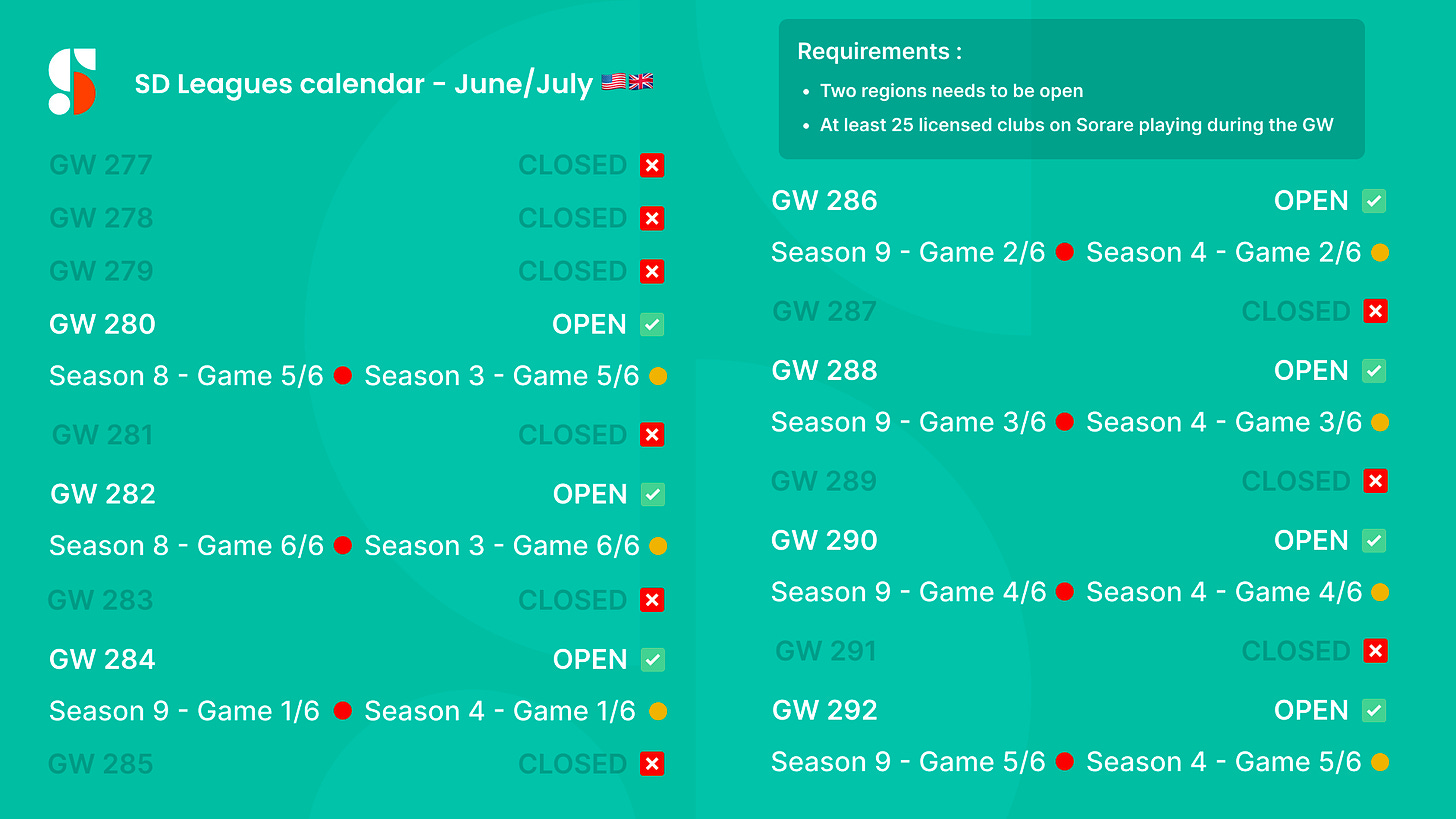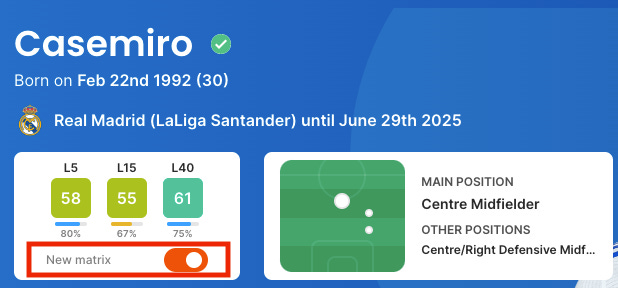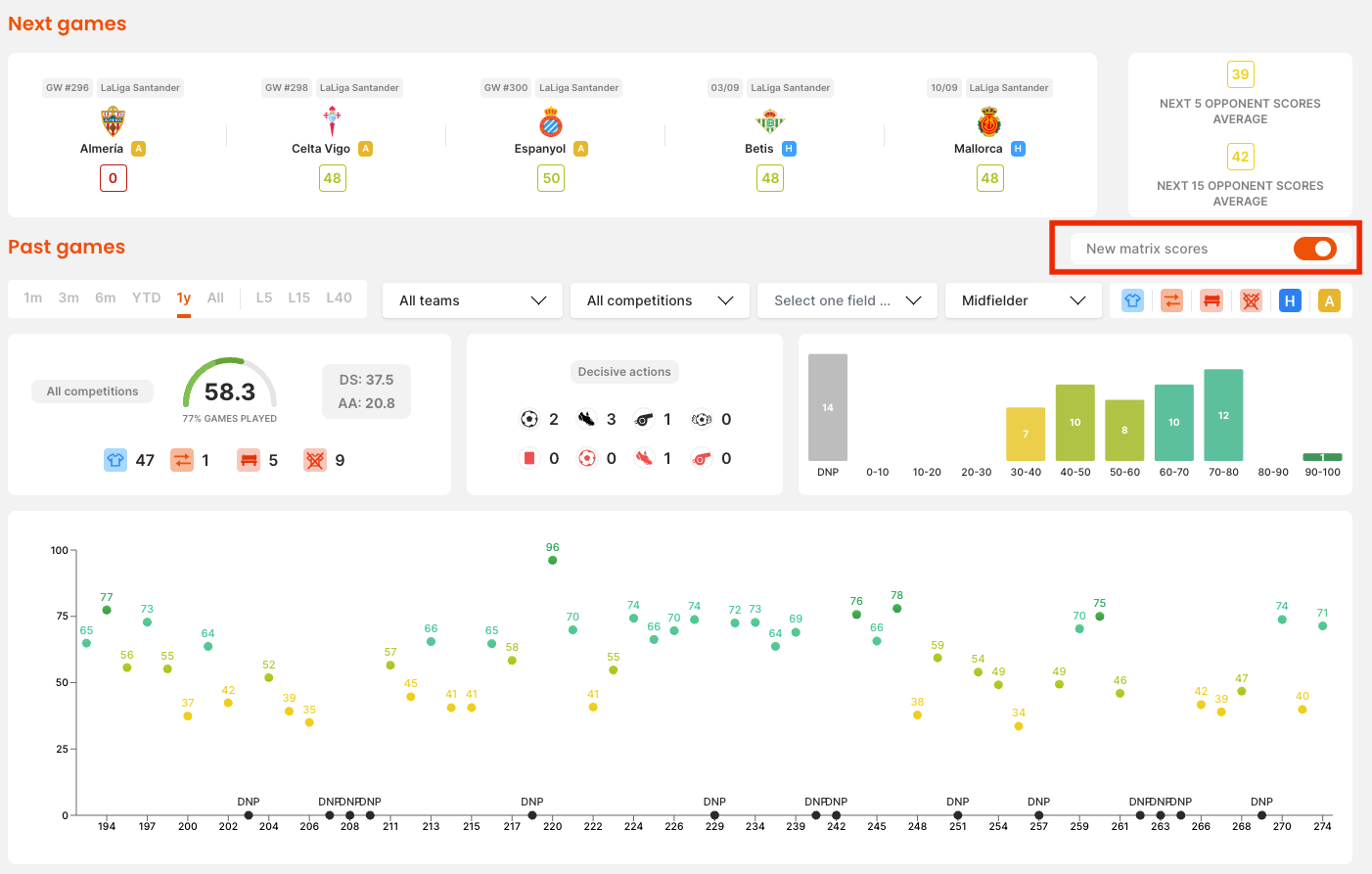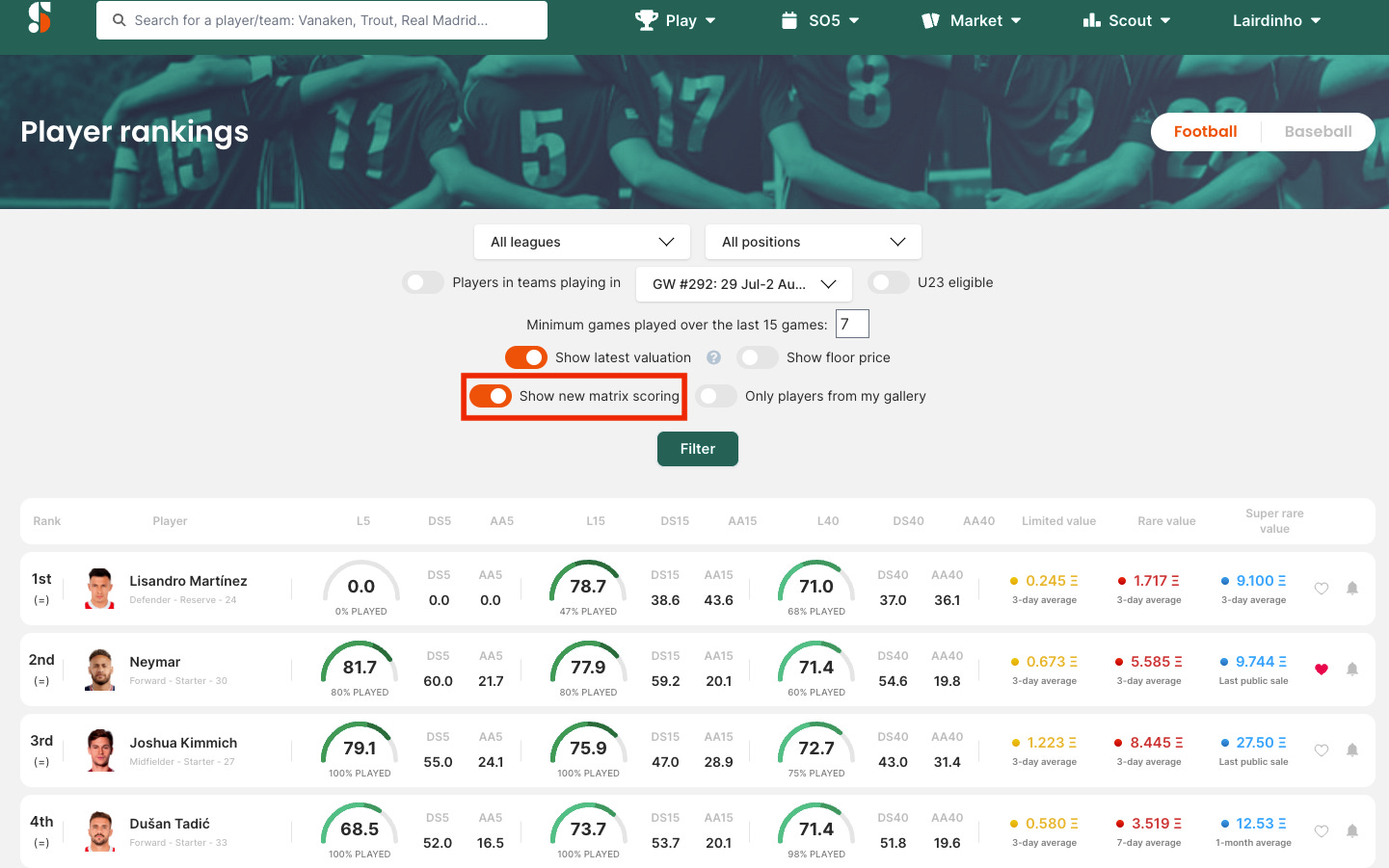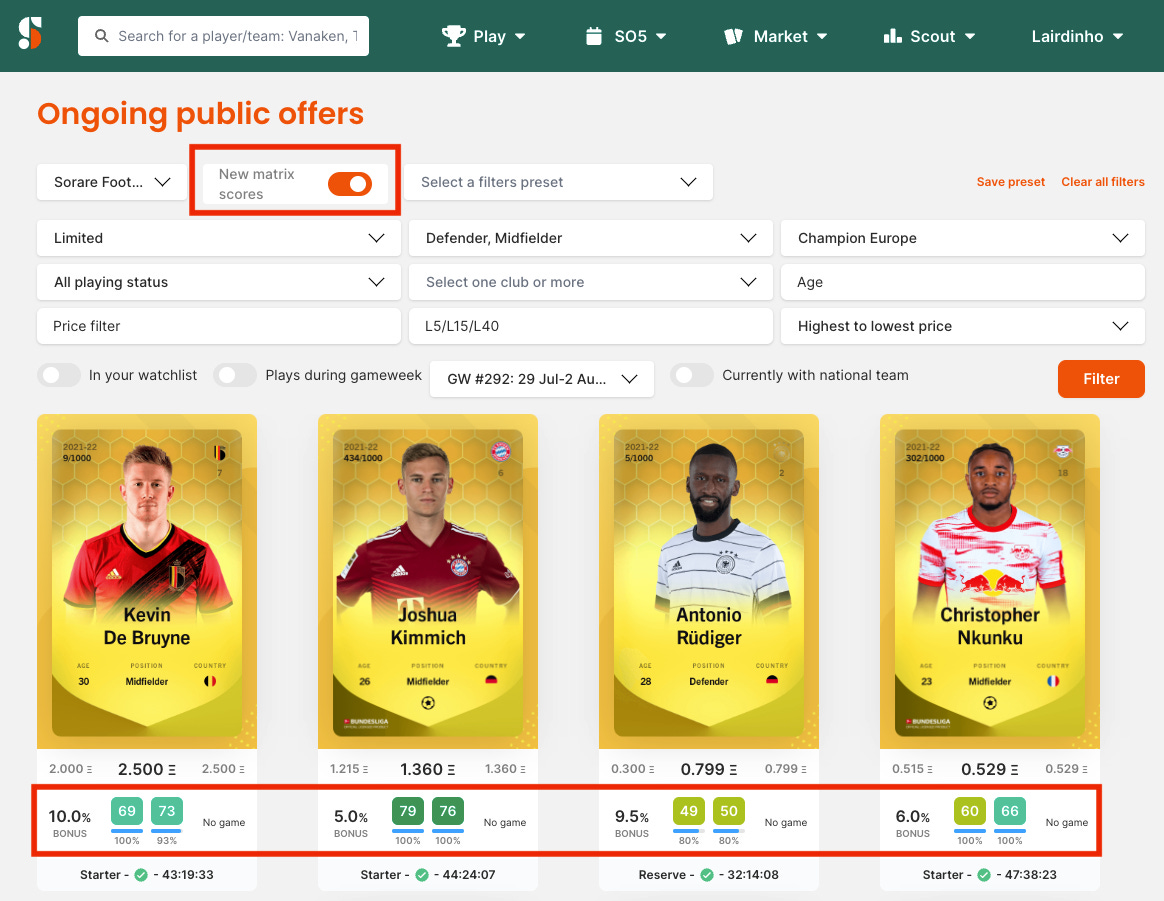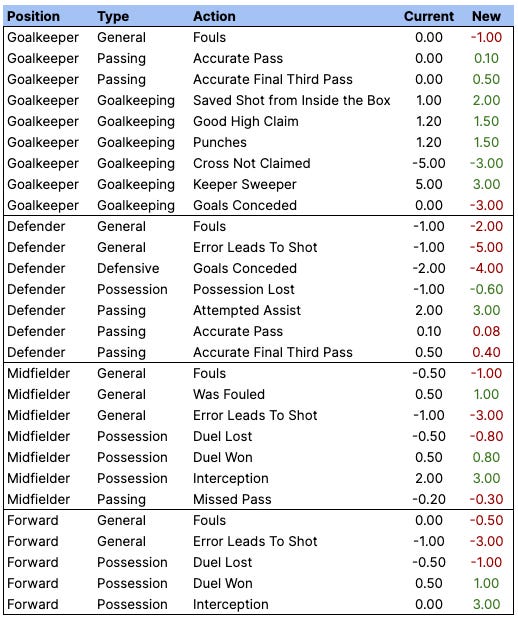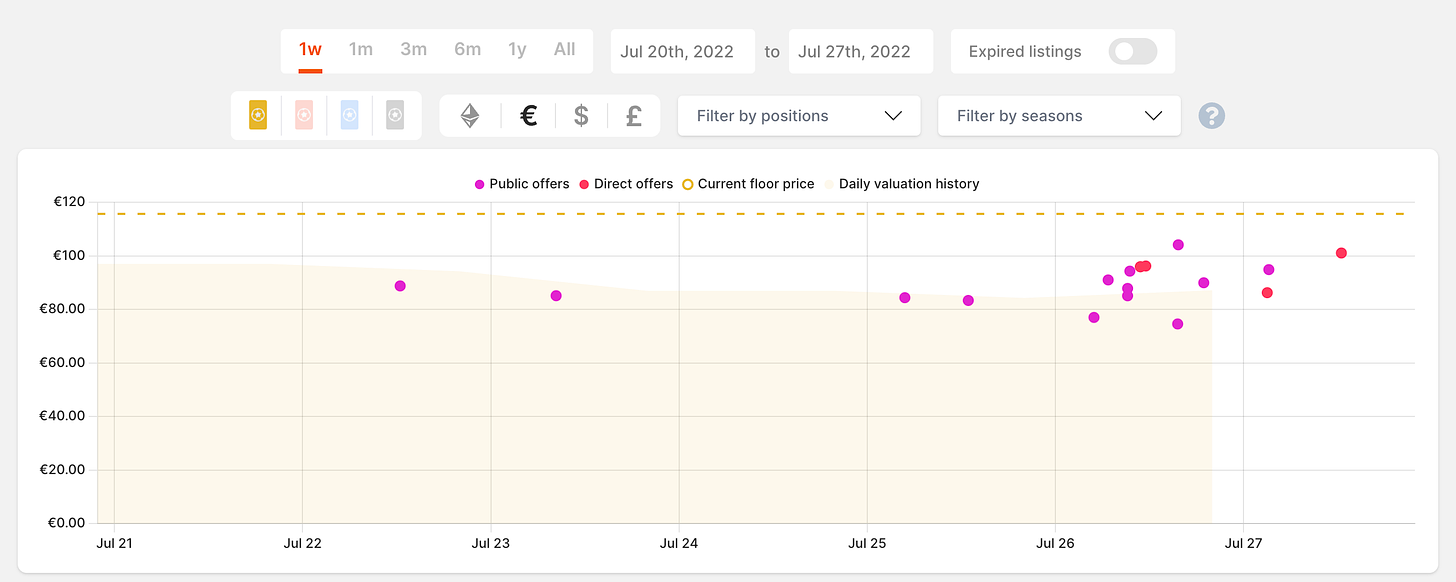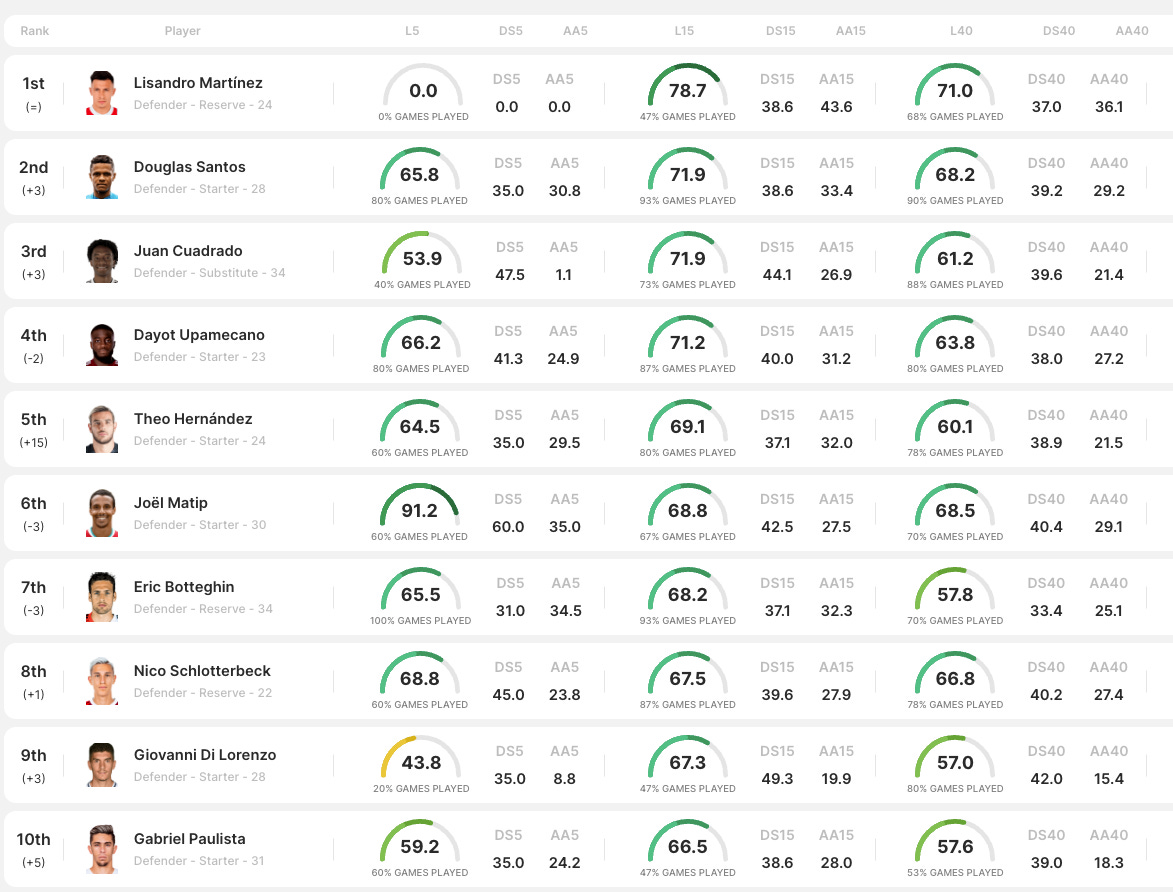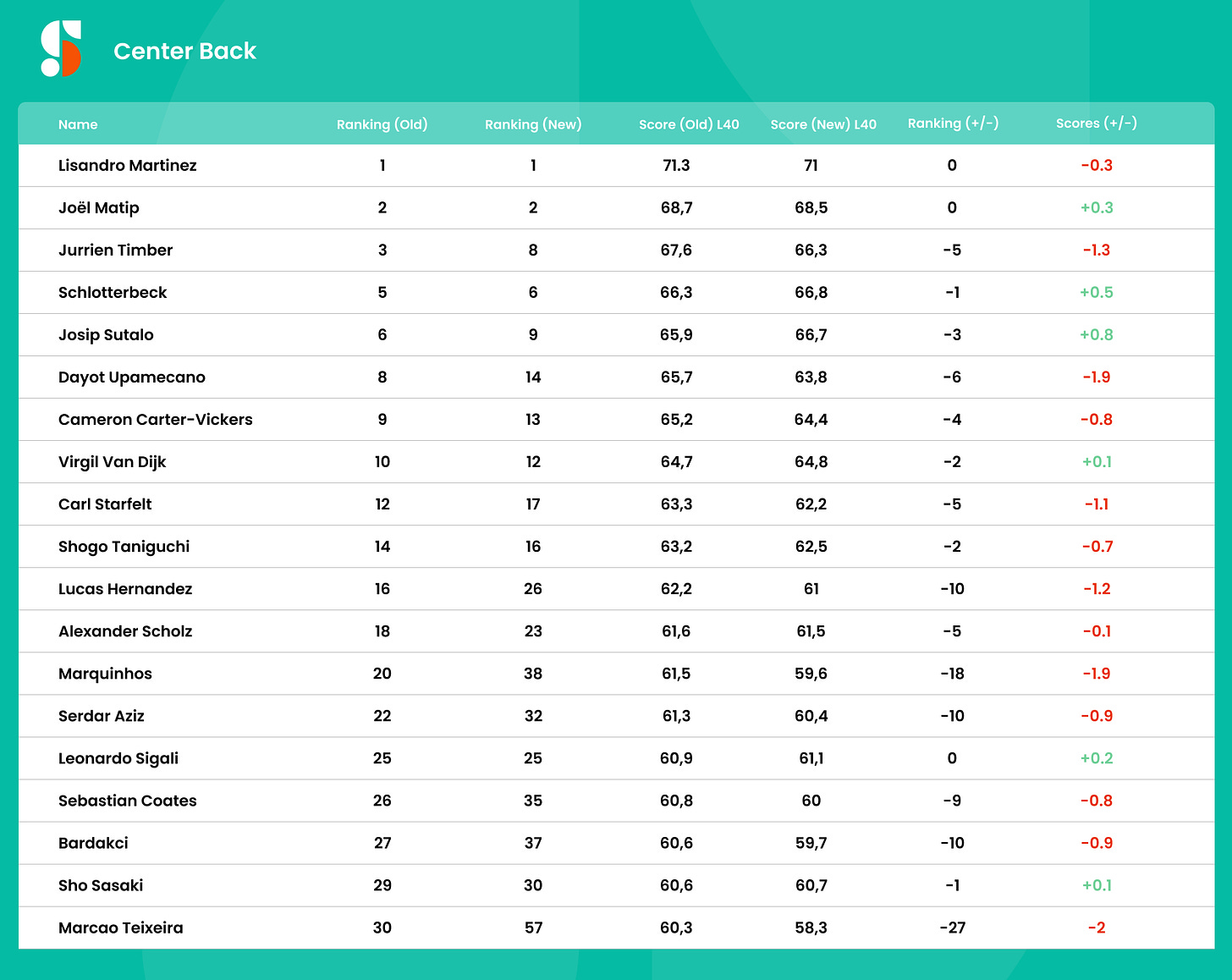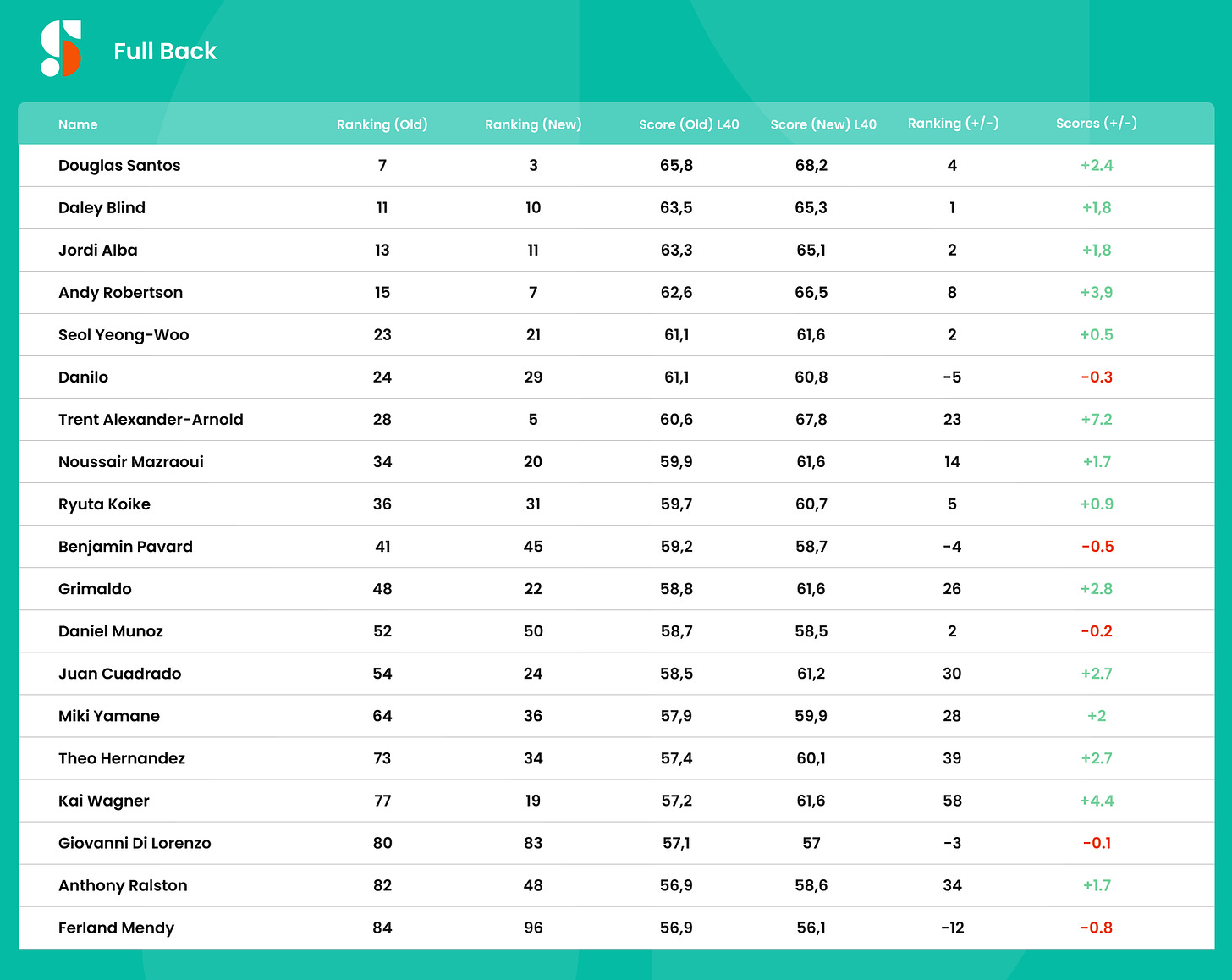SorareData Newsletter, Issue 6 ⚽️
This week’s agenda
⚽️ SorareData Leagues
What’s 🆕
Analyzing the New Scoring Matrix 🔬
📺 Latest Streams & Podcasts 🎧
⚽️ SorareData Leagues
Don’t forget to set your SorareData League lineups! Head over to our Gaming Arena to set your lineups and compete!
What’s 🆕
New scoring matrix toggles - Sorare’s introduction of new scoring rules starting in GW 300 made everyone scramble to see the scoring differences of their players or players they are interested in. There were lots of discussions and screenshots of spreadsheets going around Twitter showing the differences, but we thought it was important to offer the option for SorareData users to continue using the site as they normally would while getting the benefit of seeing the old (because we are still using it) and new scores. So, where can you see them? Let’s check them out:
Player page header
Player page SO5 Scores tab
Player rankings
Live auctions and Live offers
Simply click the toggle to easily move from the old matrix scores to the new.
Analyzing the New Scoring Matrix 🔬
Sorare introduced their new scoring matrix this week, which included fantasy-point adjustments for multiple stats at every position. Here is a quick breakdown of the changes by position:
There has been a lot of discussion already about which players will see the biggest improvements, with Liverpool’s Trent Alexander-Arnold a popular example, as his L5/L15/L40 averages improved from 48/57/61 to 54/64/68. From an L40 perspective, Alexander-Arnold moved from the 11th-highest ranked defender in Champion Europe to second, trailing only teammate Joël Matip (this only included players who actually played in a Champion Europe league last season).
We bring up Alexander-Arnold because full-backs seem to be the biggest beneficiaries of the new scoring matrix, particularly ones who participate a lot in their team’s attack by sending crosses into the box. Most of those crosses turn into lost possessions, which isn’t nearly as bad anymore, as they had a 40% penalty reduction, from minus-1.0 point per possession lost to minus-0.6. As someone who lost possession 821 times in his last 40 gameweeks, you can understand why Alexander-Arnold card owners are happy with the change.
Other full-backs who saw their average scores increase with the new scoring matrix include Lautaro Blanco (+5.3 L40), Pedro Porro (+5.2), Julian Gressel (+4.9), Guilherme (+4.4), Kai Wagner (+4.4), Andy Robertson (+3.9), Alan Mozo (+3.7), Gijs Smal (+3.7), and Alfonso Espino (+3.6), to name a few. Now, just because these players will have improved scores because of the new matrix doesn’t make them great SO5 options, as Espino is moving from an L40 of 41.4 to 44.9, which usually isn’t good enough gameweeks for rewards in most gameweeks. Nevertheless, we have already seen prices spike for some of these players, as a Porro limited card sold for €85.09 on 23 July and then €101.00 on 27 July after the new scoring was announced.
We also saw some significant changes with goalkeepers.
Steve Mandanda was the highest-ranked Champion Europe goalkeeper based on L40 at 58.8 fantasy points per game, though he only played 38% of those matches. Instead, we can look at second-ranked Alisson, who averaged 57.9 while playing 95% of games over that span. Going down the rankings, and removing anyone who didn’t play at least 60% of matches in their last 40, the 10th-ranked goalkeeper in terms of L40 was Gianluigi Donnarumma, who averaged 51.1 in 60% of matches. The 20th-ranked was Gerónimo Rulli, who averaged 49.5 in 85% of matches, and 40th was Koen Casteels, who averaged 46.5 in 68% of games. So, we see there was an 6.8-point gap between first and 10th, an 8.4-point gap between first and 20th, and an 11.4-point gap between first and 40th.
Using the new scoring matrix, Mike Maignan moves into the top spot at 59.3 points per game in his last 40 (70% games played), with Alisson second at 59.1. The 10th-ranked goalkeeper was Bono at 52.0 (85% played), the 20th-ranked was Matz Sels at 49.5 (78%), and the 40th was Juan Musso, who averaged 46.0 (75%). From a differential standpoint, the highest-ranked goalkeeper averaged 7.1 more fantasy points per game than the 10th-ranked one, 9.6 more than the 20th, and 13.1 more than the 40th.
What we’re seeing is a bigger gap between the elite goalkeepers versus the average-to-below-average ones, which is likely because every goal conceded is now a three-point reduction instead of zero, as goalkeepers were previously not punished until they conceded their third goal. Yes, they wouldn’t qualify for the clean sheet decisive action if they allowed a goal, but conceding a second goal was no more detrimental than the first. Additionally, if they did concede a third goal, every subsequent goal they allowed was unpunished by the scoring matrix, which meant allowing seven goals was just as good (or bad) as allowing three.
But we also have to remember that our SO5 lineups are not scored by averages, but what players do in each individual gameweek. Because of this, we should look beyond what L5/L15/L40 changes there have been and see how absolute scores are also adjusted. In addition to the goals conceded adjustment, we also get more points for saves inside the box, accurate passes, accurate passes in the final third, good high claims and punches, while getting a lesser penalty for crosses not claimed. What this can do is help goalkeeper score upside, particularly for those who make a lot of saves.
Remember when everyone was upset that Thibaut Courtois “only” scored 89.40 during the Champions League final against Liverpool despite making nine saves, including seven from shots inside the box? Well, the new scoring matrix now pushes him to 99.9. Courtois’ change is actually quite interesting, as his L15/L40 changes from 53.1/56.5 to 54.3/58.0, a decent increase for both. However, and maybe more importantly, we saw a change in his ceiling scores in his L40 (counting only Real Madrid matches):
We can compare this to Maignan, who we spotlighted earlier as the new top Champion Europe goalkeeper by L40 average. As we see below, Maignan sees an increase in average, but he still has fewer than half of the 80+ scores that Courtois reached.
What we can expect to see is more goalkeeper scores reaching the 80 and 90-point levels than we saw previously, though the elite keepers will still be more consistently high-scoring.
Let’s go back to defenders for a moment because we didn’t address what we did with goalkeepers, which is that the number of raw points up or down doesn’t matter nearly as much as the differential between others at the position. A 5.5-point increase sounds good, but if everyone is increasing as well then it doesn’t really matter.
Let’s use Challenger Europe this time, which obviously points us to Ajax’s Jurriën Timber, whose 67.6 L40 average currently tops the division (his former teammate, Lisandro Martínez, was actually the top at 71.0, but he has transferred to Manchester United in Champion Europe). Using the same methodology as before, we see Nicolás Otamendi as the 10th-ranked defender using the old scoring matrix with a 60.1 L40 (85% games played), Anthony Ralston 20th at 56.9 (73%) and Dominik Baumgartner 40th at 54.4 (85%). However, if we change to the new scoring matrix, Douglas Santos moves to the top with a 68.2 L40 (90% played), Sebastián Coates is 10th at 60.0 (83%), Gernot Trauner is 20th at 57.2 (83%), and Reto Ziegler is 40th at 54.7 (93%).
Let’s review how each of these players’ L40 ranks moved from the old matrix to the new:
Timber: 1 ⬇️ 3
Otamendi: 10 ⬇️ 17
Ralston: 20 ⬆️ 15
Baumgartner: 40 ⬇️ 49
Douglas Santos: 4 ⬆️ 1
Coates: 8 ⬇️ 10
Trauner: 16 ⬇️ 20
Ziegler: 43 ⬆️ 40
Using the same table as we did with the goalkeepers, we see a much smaller gap between the old and new differentials, moving less than a point in these cases.
Remember that we’re not using the same players in these examples, only the places in the rankings, but it’s still important to recognize that the averages to reach these rankings aren’t changing that much.
To analyze it from a player perspective, you can easily see the changes from an L15 perspective on our player rankings page, which will not only show where a player ranks among his peers, but also the change in ranking from the old scoring matrix to the new one.
As we see in the graphic above, which shows all defenders, Theo Hernández moves up 15 places, from 20th to 5th, with his L15 going from 56.5 to 58.8. There are a plethora of examples of players moving fairly significantly in the rankings because of the change in scoring rules, and we highly recommend taking some time to understand why certain players have moved, and whether it’s reasonable to expect them to continue to rise or fall.
Sorare mentioned that the score changes were minimal for most players, which we saw for the most part other than players like Alexander-Arnold and Theo Hernández. Nevertheless, even if the points drop is minimal, it can have a big impact in SO5. For example, Marquinhos was the 20th-ranked L40 defender overall using the old scoring matrix, and he loses 1.9 fantasy points per game with the new scoring. However, his new average now places him 38th among defenders. The same can be seen with someone like Lucas Hernández, who loses only 1.2 points but falls 10 places in the rankings.
What does this mean? For Marquinhos, without taking into account his star status and stability at Paris Saint-Germain, it means that there are now 37 defenders who averaged more fantasy points per game over the last 40 gameweeks versus only 19 before, which seems to make him a little more replaceable.
Our point is that observing a score in raw value, such as saying “his score has only changed by 1.9 points per game,” isn’t sufficient analysis. We play against other managers on Sorare, so we have to have a relative approach to variations, which the rankings on SorareData allows us to see. Kai Wagner will see his fantasy-point average increase by 4.4 points per game, but beyond that we see that he moves from being the 77th-ranked defender to 19th (almost where Marquinhos was before the change).
One last thing we should mention is that all of these rankings are based on prior scores; they do not include any sort of projection for the future. Because of that, Lisandro Martínez shows as the top-ranked player on the site, but he accomplished that feat because of his play with Ajax, who he no longer plays for after transferring to Manchester United. Many are expecting his scores to decrease because he is playing in a much tougher league, so it’s important to remember that there are many factors outside the rankings that could cause a player to move significantly once the season begins. On the other hand, you may see a player who has a small adjustment to their L5/L15/L40 averages because of what they accomplished last season, but they could be in for a big increase this season because they now play for a better team. Use these figures as a guide in your decision-making process, but quickly making moves on players solely because of their SO5 averages change may be riskier than initially believed.
📺 Latest Streams & Podcasts 🎧
🚨Live at 12pm EDT/5pm BST/6pm CET on Friday!🚨
SorareData Strategy Show: New Scoring Matrix
Lairdinho and psufans2 discuss the new SO5 scoring rules on Sorare, including which players benefit the most, and whether any of their player-acquisition strategies have changed heading into the new European season.
SorareAndrews Podcast: You Don’t Have to Play Everything
Lairdinho and Black discuss why many Sorare managers feel pressure to compete in as many competitions, and now sports, as possible, and why it's important to step back and focus on quality over quantity.
SorareData Strategy Show: Building a €1000 Limited Gallery
Lairdinho and psufans2 take on the task of building a limited gallery for the upcoming European season with a budget of no more than €1000.




